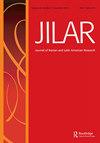Flávio德巴罗斯卡努多斯战争照片中的实证主义与进化论
IF 0.3
0 HUMANITIES, MULTIDISCIPLINARY
Journal of Iberian and Latin American Research
Pub Date : 2023-01-02
DOI:10.1080/13260219.2023.2218071
引用次数: 0
摘要
摘要卡诺多斯战争是巴西共和国成立初期的一个关键时刻。最终导致Canudos定居点被毁的事件在该国历史上留下了不可磨灭的印记。Canudos在巴西历史上的突出地位可以部分解释为它是欧几里得·达·库尼亚的《Os sertões》(1902)的主题,该书的第一版包括Flávio de Barros拍摄的三张照片。德·巴罗斯拍摄的卡努多斯的照片受到的关注不如达库尼亚的书。本文探讨了德·巴罗斯的图像作为Os sertões的视觉伴奏的工作方式。他们所讲的是当时著名的实证主义和进化论理论。虽然这些照片呈现了对冲突的官方叙述,但它们象征着战争的残酷,并引起了对康塞尔海罗定居点居民的同情。本文章由计算机程序翻译,如有差异,请以英文原文为准。
Positivism and Evolutionism in Flávio de Barros’s Photographs of the Canudos War
ABSTRACT The Canudos War was a pivotal moment in the early years of the Brazilian republic. The events that culminated in the destruction of the settlement of Canudos left an indelible mark on the country’s history. Canudos’s prominence within Brazilian history can be partly explained by the fact that it is the subject of Euclides da Cunha’s Os sertões (1902), the first edition of which included three photographs taken by Flávio de Barros. De Barros’s photographs of Canudos have received less attention than Da Cunha’s book. This article explores the way in which De Barros’s images work as a visual accompaniment to Os sertões. They speak to the same positivist and evolutionist theories that were prominent at the time. While the photographs presented an official narrative of the conflict, they came to symbolize the cruelty of war and engendered sympathy for the inhabitants of Conselheiro’s settlement.
求助全文
通过发布文献求助,成功后即可免费获取论文全文。
去求助
来源期刊

Journal of Iberian and Latin American Research
HUMANITIES, MULTIDISCIPLINARY-
CiteScore
0.60
自引率
0.00%
发文量
22
 求助内容:
求助内容: 应助结果提醒方式:
应助结果提醒方式:


